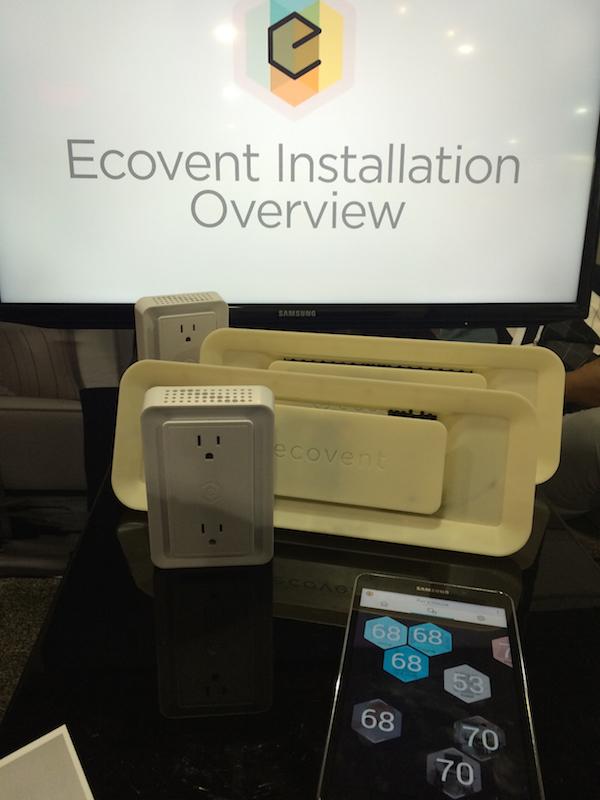I cannot cite a source, but I recall reading that it's generally not a good idea to close too many vents in an HVAC system. The gist is that the systems tend to work most efficiently when they are running constantly. The systems are less efficient when cycling on and off. A properly-sized system for a house should kick on, run constantly for a while to achieve a target temperature increase/decrease, and then kick off again. A system that is too big would not stay on long enough for efficiency purposes. It seems like this type of a system would cause the HVAC system to be too big for the house.
Vent Your Heating & Cooling Frustrations with Ecovent

Put simply, Ecovent makes replacement, “smart” HVAC vents and separate environmental sensors that monitors each room in which a vent (or vents) is installed and controls the flow of air into the room based on what you and/or the system determines is the appropriate temperature when the room is occupied and unoccupied. You can think of an Ecovent system as the equivalent of light switches throughout your home. With most current HVAC systems, when the furnace is on, for example, you’re pumping hot air into every room – regardless of whether you’re occupying that room or not. It’s as if you had only one light switch for home and your only choices are all the lights on or all the lights off. Ecovent systems provide individual control of the heating and cooling on a room-by-room basis.
Ecovents can be easily installed in any home – new construction or existing house. And when I say “easy”, I mean stupidly, dead simple easy. Ecovent’s smart vents replace the existing HVAC vents in your home. They’ll come in a variety of sizes to fit the various sized vents that have been installed in home over the years. Ecovents are wireless and use four AA batteries, which Ecovent claims should last close to three years before they need to be replaced. Ecovent environmental sensors simply plug in to an existing AC outlet. They include two outlets, so you don’t lose access to the original outlets, in addition to a couple of 2 Amp USB charging ports.
Ecovents include a motorized, rubber “curtain” that opens and closes behind the front face of the vent in order to let more or less air pass through. The rubber curtain is concealed behind the flat face of the vent, and the airflow is directed 360 degrees around the outer edge of the vent. Because Ecovents don’t incorporate louvers, airflow into the room is not only more efficient – it’s significantly quieter. While this is certainly a good thing in general, the minimal noise output of the vents make them ideal for use in home theaters and rooms where serious music listening is done.
Ecovent says it’s difficult to give an exact figure on how much an Ecovent system will save a homeowner but general heating and cooling cost savings can run as much as 30-40%. Shipments are expected to begin mid-year.
- Log in or register to post comments


You're right; furnace motors are designed to work within a limited range of back pressure. Too much back pressure makes the motor work harder, which lowers efficiency and can lead to premature failure. I would imagine these auto-louvers would work in tandem with the main furnace, so when the desired overall temperatures are reached, the furnace would still shut off....don't forget that the more vents are closed, the faster the remaining rooms would get to their ideal temperature.
I'm more skeptical of the ability of a plug-based thermostat to adequately gauge the temperature of a room(don't forget, most thermostats are installed at torso/chest level, not down on the ground). Especially with that hot wall-wart plugged in that's charging your devices or running your laptop.

You are correct that each fan is rated to a specific back pressure. However, a constant speed fan will actually do less work with less flow while a variable speed may work harder trying to compensate. The other danger is over-cooling or over heating your system due to lack of airflow. With the sensors in our vents we ensure that your system doesn't reach a dangerous state. We do work with communicating thermostats so that we can turn off the furnace/AC when needed.
You have identified another key to our design. Our sensors incorporate sensors and algorithms to estimate the room temperature both at the correct height and away from the wall that they are mounted on. Our sensors are highly isolated within the housing such that a plugged in device or a phone charging on our USB ports will not affect our air temperature readings. Thanks for commenting! -Nick

Hi, I'm the CTO of Ecovent. Your concerns are well placed. It is definitely possible to close too many vents in an HVAC system. You are also correct in that there is an optimal run time for the system. Our controls ensure that your system runs for the minimum amount of time required for system health even if you get a little too much conditioned air. When this is necessary, the system automatically puts the extra air in the area least likely to cause discomfort. Every home is different, and we're working to engineer our system such that we maximize the comfort delivered by every system without causing damage. Thanks for the comment. -Nick




















































